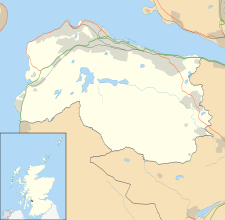Ravenscraig Hospital
| Ravenscraig Hospital | |
|---|---|
| NHS Greater Glasgow and Clyde | |
 Ravenscraig Hospital | |
| Geography | |
| Location | Inverkip Road, Greenock, Scotland |
| Coordinates | 55°56′18″N 4°47′58″W / 55.9384°N 4.7995°W |
| Organisation | |
| Care system | NHS Scotland |
| Type | Mental health |
| Services | |
| Emergency department | No |
| History | |
| Opened | 1879 |
| Closed | 2014 |
| Links | |
| Lists | Hospitals in Scotland |
Ravenscraig Hospital was a mental health facility in Inverkip Road, Greenock, Scotland. It was managed by NHS Greater Glasgow and Clyde.
History
[edit]The foundation stone for the facility was laid by Earl of Mar and Kellie in September 1876.[1] The facility was opened as the Smithston Asylum in March 1879.[2] It served as a military hospital for wounded soldiers in the First World war and as a naval hospital for Canadian sailors during the Second World War.[2] It joined the National Health Service as Ravenscraig Hospital in 1948 and two new 120-bedded units known as Corlic and Dunrod were built to the north of the main building in the 1960s.[2] The original building closed in December 2005[2] and the remainder of the facilities closed in 2014.[3]
The site was subsequently sold to a residential developer for a nominal sum; however in March 2019 toxic chemical contamination was found on the site giving rise to concerns about the development.[4]
See also
[edit]References
[edit]- ^ "History of Ravenscraig Hospital". Greenock Telegraph. 14 February 2012. Retrieved 2 February 2020.
- ^ a b c d "Records of Ravenscraig Hospital, Greenock, Scotland". Archives Hub. Retrieved 2 February 2020.
- ^ "NHS bosses built Ravenscraig Hospital on toxic land riddled with dangerous contaminants and operated it for decades". Greenock Telegraph. 10 August 2019. Retrieved 2 February 2020.
- ^ "Ravenscraig special: Toxic chemical contamination at the site of a former hospital is more than 800 per cent above acceptable levels". Greenock Telegraph. 3 March 2019. Retrieved 2 February 2020.
- Hospitals in Inverclyde
- 1879 establishments in Scotland
- Hospitals established in 1879
- Hospital buildings completed in 1879
- Defunct hospitals in Scotland
- Former psychiatric hospitals in Scotland
- Listed hospital buildings in Scotland
- Category B listed buildings in Inverclyde
- Buildings and structures in Greenock

